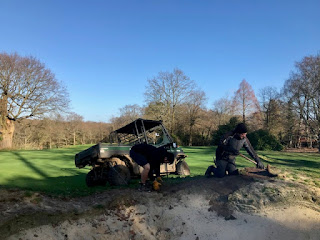One of the questions I get asked a lot is what do you guys do in the winter? Well I thought it might be easier to add a copy of the winter programme I give to the MC to show all the areas we are planning on working on. This is weather depending and a rough guide because like we know in life, things come up that have to be dealt with (for example: High winds may bring trees down or snow may stop aeration and turfing works).
As you can see the winter works are pretty busy, some would say busier than summer. With normal tasks taking longer.
In the Summer one member of staff can cut the greens using a triple mower (ride on) in 3.5 hours including Pre start checks and washing down. In the winter, the greens are hand mown. This takes four members of the team 3 hours to do including set ups and wash down. That's 8.5 hours more for the same task. That's not including having two staff members blowing leaves off the greens so they can get cut, again this takes 3 hours. So cutting greens alone takes 14.5 hours compared to 3.5! The reason we hand cut is to minimise compaction on the greens and damage around the course and I think we can all agree our greens in the winter have definitely moved forward.
 |
| Lighting kits have been added to machinery to help us set the course up in the winter months |
During the summer course set ups normally include mowing greens daily and rolling them three/four times a week. In the winter the growth drops away but our disease pressure intensifies. Removing dew in the morning is one of main tasks as long spells of moisture on the leaf cause turf diseases, especially when its mild. The greens are dewied most days in the winter unless being cut, rolled or frost. This is done by Dewie brushes. These are 6ft wide brushes that the team push round the greens to knock the dew off. Walking around 12,000 steps by 8.30am...
 |
| Dewing Greens |
One question I sometimes get asked, is Why are the team driving around the course when we cannot take trolleys? Well in short if it gets too bad, we will not! Driving in the winter is kept to a minimum but due to the amount of equipment needed to carryout a course set up, it's not possible to walk around with it all.
(Tools for morning set up : Blowers x 2, Squeegee x 1, Hole changer-board-bucket with flags-hole puller-scissors-top hat-syringe, shovels x 2, swish x 1, bin bags, divot mix, white paint and head lamps)
We are lucky at Stoneham to have the old 'Stoneham Park House' driveway which went down to the fishing lakes (originally the house lakes) Below is a picture of the lakes with the house in the background. I am going off piste a bit but the now internal greenkeepers path which has been extended over the years runs from the Greenkeepers yard round to the 12th meaning we can drive around in the winter and the team can stick to this, but have all the tools they may need close by. Sometimes this may require a few trips back and forth to the machine to get everything we need.
However, Golfers tend to follow the same routes due to the nature of the game and in these areas that damage is caused. Roping off areas to stop people with carry bags as well as trolleys from causing to much damage its essential. We have introduced rubber mats to walk on and turfed areas with rubber mats on top, so the grass can grow through. This then becomes a hard wearing area that looks more natural in the summer. We plan to intro more of these in the future.
Please remember that banning trolleys is the last thing we want to do and when we ask for you to make every effort to carry your bag, we hope that those who can honestly say they need one will and those who can carry will. If you are young, fit and healthy... you can carry your bag! It's your golf course but damage costs can spiral if trolleys are used when damage can be caused but its the members that eventually end up with the bill...
Anyway back to the winter program. You can see we break this down four main areas;-
- Renovation/Maintenance
- Construction
- Other
- Woodland Management
Renovation and maintenance- These areas are really general greenkeeping duties (Aeration, Seeding, Irrigation, Cutting etc).
Construction - This is pretty obvious and includes all major works and tasks that take a bit of time to complete.
 |
| Stripping back the dead turf from the summer |
 |
| After being re turfed |
Other - This is where our time allocation goes mainly outside of daily work and projects. Leaf clearance (remember this takes over 900 man hours every winter from October to December alone and is a huge drain on our resources but we have other tasks to do at the same time and it's my job to prioritise these), shrub cutting and clearance, health and safety updates etc.
Woodland Management- We have huge areas of woodlands, these are as big as the golf course (playing areas) and this area need to be managed. We are lucky to have the 'Bon fire crew' who help us on Tuesdays to maintain these areas but its at this time of year our attentions turn to these areas as the growth rates drop.
All of the above works need to be carried out along with our daily set ups, cutting of the course and anything else that may come up. You can see from what I have said earlier, tasks take longer in the winter, even basics like course set up and cutting greens. We have also have other priorities, like keeping the dew off the greens and then the issue of leaves, turf that needs to be down early enough to root and get recovery ahead of the summer.
Planning like this helps us to focus on what is important for the long run and not just the short run and enables us to keep moving the course forward!
See you all soon and wrap up warm
Matt
















